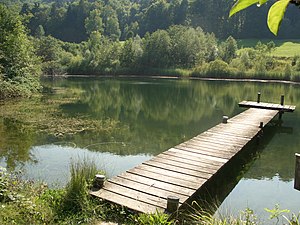Dättnauerweiher
| Dättnauerweiher | ||
|---|---|---|

|
||
| The front pond | ||
| Geographical location | in the Dättnauertal | |
| Tributaries | Dättnauerbach | |
| Drain | Dättnauerbach | |
| Islands | an unnamed island in the back pond | |
| Location close to the shore | Winterthur (quarters Dättnau and Neuburg ) | |
| Data | ||
| Coordinates | 694 085 / 260466 | |
|
|
||
| Altitude above sea level | 486 m above sea level M. | |
| surface | approx. 1.6 ha | |
The Dättnauerweiher are two ponds in the Dättnauertal in Winterthur that were created in 1992 and are now a nature reserve.
history
More or less large ponds in the Dättnauertal are already shown on historical maps. For example, on a map from 1784 there is a body of water designated as the "Grosser Weyer", which, however, was not located at the location of today's Dättnauerweyer, but continued towards Neuburg. With the drainage of the Weiertal in 1921, however, this pond also disappeared again.
Today's Dättnauerweiher emerged from the pit of the clay quarrying stopped in 1988 by the Dättnau brickworks, during the excavation of which from 1968 to 1988 valuable knowledge about the vegetation of the Dättnau was made in the last thousand years after the last ice age through the discovery of fossil tree remains. After the clay mining ended in 1991/92, the pit was filled with water by the city of Winterthur and divided into two ponds by a dam, one as a deep and the other as a shallow water zone. The ponds have been slightly planted. There are waste ground applied with pools and along the Dättnauerstrasse were for the migrating frogs, toads and newts amphibians tunnel created.
Flora and fauna
The Dättnauerweiher is now a nature reserve of cantonal and amphibian spawning waters of national importance.
In a plant survey in 2001, 20 different woody species and almost 200 herbaceous, aquatic and meadow plants were counted around the pond, 20 of which are rare to very rare. The species found include, for example, the common centaury and the purple loosestrife .
In addition, the Dättnauerweiher is an important amphibian spawning water. Common frogs , water frogs , common toads , yellow-bellied toads spawn on its banks and the mountain newt and the newt have already been seen.
Around the pond, around a third of the native dragonflies can be counted with 24 species , including, for example, the fire dragonfly , the flat-bellied dragonfly or the great royal dragonfly . There are also 15 different butterflies around the pond, for example the big ox-eye , the little meadow bird , the blue grouse and, very rarely, the violet butterfly . There are also twelve different species of grasshopper , with the common shrub insect , the brown grasshopper , the leek insect and the red club insect being the most common. The green hay horse , the field cricket or the European mole cricket are rather rare . The sand lizard feels at home in the ruderal areas .
Web links
- Lehmgrube Dättnau nature reserve on the sides of the city of Winterthur.
Individual evidence
- ^ GIS browser of the Canton of Zurich
- ^ City of Winterthur (Ed.): Landscape in Change . Dättnau - Wülflingen nature trail. ( stadt.winterthur.ch [PDF; 1.6 MB ; accessed on October 4, 2018] Flyer).
- ↑ Michael Wiesner : Forest time: forests for Winterthur . Naturwissenschaftliche Gesellschaft Winterthur, Winterthur 1997, ISBN 3-9521356-0-7 , Chapter 4 ( waldzeit.ch [accessed on May 6, 2018]).
- ↑ a b Plants and animals in the Dättnau valley. City of Winterthur, accessed on October 4, 2018 .
- ↑ Dättnau clay pit. City of Winterthur, accessed on October 4, 2018 .
